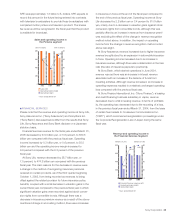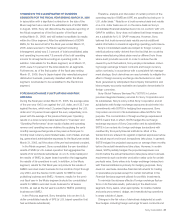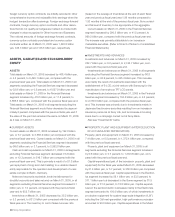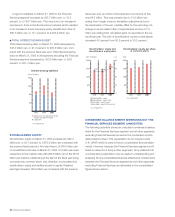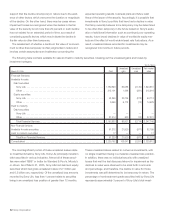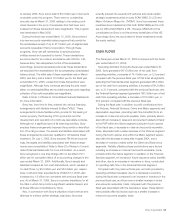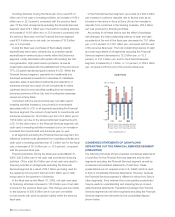Sony 2005 Annual Report Download - page 58
Download and view the complete annual report
Please find page 58 of the 2005 Sony annual report below. You can navigate through the pages in the report by either clicking on the pages listed below, or by using the keyword search tool below to find specific information within the annual report.Sony Corporation 55
to January 2005, Sony sold a total of 80.3 billion yen of accounts
receivable under this program. There were no outstanding
amounts due at March 31, 2005 relating to the existing undi-
vided interests in the pool of receivables that had been sold.
Losses from these transactions were insignificant. This program
was terminated in May 2005.
During the fiscal year ended March 31, 2005, Sony entered
into new accounts receivable sales programs that provide for
the accelerated receipt of up to 47.5 billion yen of eligible trade
accounts receivable of Sony Corporation. Through these
programs, Sony can sell receivables to special purpose
entities owned and operated by banks. These transactions
are accounted for as a sale in accordance with FAS No. 140,
because Sony has relinquished control of the receivables.
Accordingly, accounts receivable sold under these transactions
are excluded from receivables in the accompanying consolidated
balance sheet. The initial sale of these receivables was in March
2005, and Sony sold a total of 10.0 billion yen for the fiscal year
ended March 31, 2005. Losses from these transactions were
insignificant. Although Sony continues servicing the sold receiv-
ables, no servicing liabilities are recorded because costs regarding
collection of the sold receivables are insignificant.
Refer to Note 7 of Notes to Consolidated Financial Statements
for more information.
Sony has, from time to time, entered into various financing
arrangements with Variable Interest Entities (“VIEs”). These
arrangements include facilities which provide for the leasing of
certain property, the financing of film production and the
development and operation of a multi-use real estate complex.
Although not a significant part of its financing activities, Sony
employs these arrangements because they provide a diversifica-
tion of funding sources. The assets and liabilities associated with
these arrangements previously qualified for off-balance sheet
treatment. On July 1, 2003, Sony adopted FIN 46 and accord-
ingly, the assets and liabilities associated with these arrange-
ments were consolidated. Refer to Note 23 of Notes to Consoli-
dated Financial Statements for more information. As a result,
Sony recognized a one time charge with no tax effect of 2.1
billion yen for cumulative effect of an accounting change for the
year ended March 31, 2004. Additionally, Sony’s assets and
liabilities increased as non-cash transactions, which resulted in
no cash flows, by 95.3 billion yen and 98.0 billion yen, respec-
tively. Cash and cash equivalents as of March 31, 2005, also
increased by 1.5 billion yen compared with previous fiscal year-
end. As of March 31, 2005, Sony is a primary beneficiary for all
the VIEs in which Sony holds a significant variable interest, and
all these VIEs are consolidated by Sony.
Also, in connection with Sony’s utilization of joint venture and
alliances to achieve certain strategic objectives, Sony has
recently entered into several joint ventures and made certain
strategic investments which include SONY BMG, S-LCD and
Metro–Goldwyn–Mayer Inc. (“MGM”). Sony has reviewed these
investments and determined that both SONY BMG and S-LCD
are not VIEs while MGM is a VIE. However, MGM will not be
consolidated as Sony is not the primary beneficiary of this VIE.
Accordingly, Sony has accounted for these investments under
the equity method.
CASH FLOWS
(The fiscal year ended March 31, 2005 compared with the fiscal
year ended March 31, 2004)
Operating Activities: During the fiscal year ended March 31,
2005, Sony generated 647.0 billion yen of net cash from
operating activities, a increase of 14.4 billion yen, or 2.3 percent
compared with the previous fiscal year. Of this total, all segments
excluding the Financial Services segment generated 485.4 billion
yen of net cash from operating activities, a increase of 84.3 billion
yen, or 21.0 percent, compared with the previous fiscal year, and
the Financial Services segment generated 168.1 billion yen of net
cash from operating activities, a decrease of 73.5 billion yen, or
30.4 percent, compared with the previous fiscal year.
During the fiscal year, in addition to profit contributions from
the Pictures, Financial Services, Game and Music segments and
depreciation expenses, operating cash flow benefited from an
increase in notes and accounts payable, trade, primarily associ-
ated with an increase in sales and procurement related primarily
to the PSP within the Game segment during the fourth quarter
of the fiscal year, a decrease in notes and accounts receivable,
trade, associated with a sales decrease in the Pictures segment
during the fourth quarter and within the Music segment associ-
ated with the decrease in sales after August 2004, and a
decrease in inventory mainly within the Game and Electronics
segments. Partially offsetting these contributions were factors
including an increase in notes and accounts receivable, trade
primarily within the Game segment. In addition, in the Financial
Services segment, an increase in future insurance policy benefits
and other, due to an increase in insurance-in-force, contributed
to operating cash flow in the Financial Services segment.
Compared with the previous fiscal year, net cash provided by
operating activities increased, due to a decrease in inventory
during the fiscal year compared to an increase in inventory in the
previous fiscal year, and there was a smaller increase in notes
and accounts receivable, trade, compared with the previous
fiscal year associated with the decrease in sales. These factors
were partially offset by factors such as a smaller increase in
notes and accounts payable, trade.
BH6/30 Adobe PageMaker 6.0J /PPC


